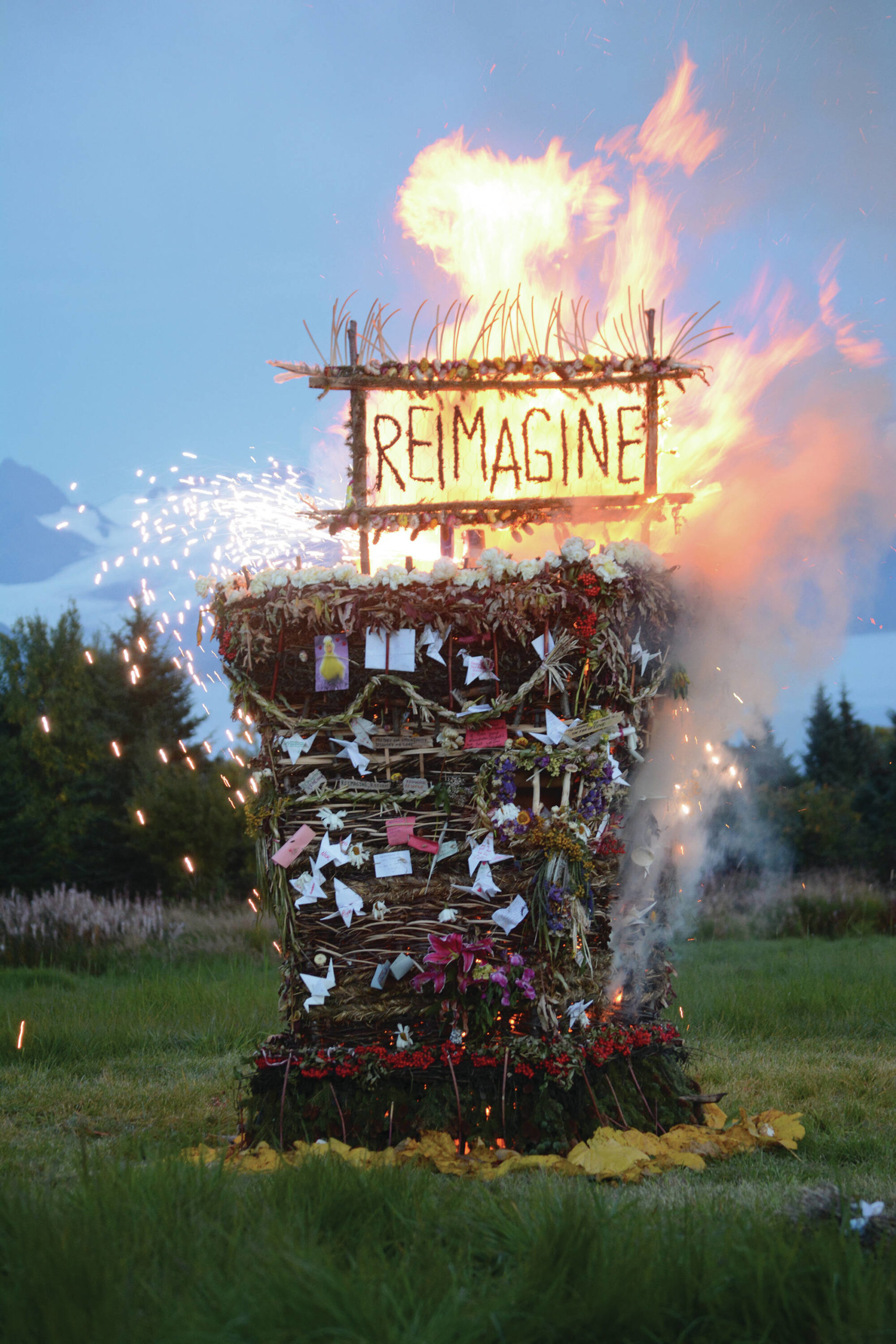Not even the COVID-19 pandemic could stop the annual Burning Basket last year, though organizer Mavis Muller held the ceremonial lighting of a scaled-back basket in private and livestreamed online. This year, the project Muller calls “a community interactive, impermanent art experience” returns to its place of origin: the Homer Spit beach at Mariner Park.
Over the past few weeks, Muller and volunteers have been building and weaving the basket, “Recover,” in the fields of her East End Road home, watched over by curious sandhill cranes. Created in transportable pieces, on Thursday the basket will be moved to Mariner Park and installed. Final decorations will be made, and on Friday, it becomes available for public interaction through Sunday evening at sundown. Then, it will be transformed into the energy of heat and light.
Conscious of the current high COVID-19 case numbers, Muller has made some changes to the usual Burning Basket experience. People will be encouraged to wear face masks and spread out. She suggested people write the word “recover” on their masks.
“And then with every breath we take, we will be part of the art with this basket called ‘recover,’” she said.
To help keep people moving around and not clumping together, volunteers in Muller’s bee costumes that have been seen at parades will swarm about.
“There are going to be people wandering around with these signs, with a sign that says ‘Let’s spread out,’” Muller said.
Subtitled “a basket of remembrance and unburdening,” the Burning Basket has created a tradition where people recall those who have died or been lost. The basket design includes portals in which people can drop notes or mementos. One portal will be for those loved and lost, including missing women and children. People often drop mementos in the basket, like one woman’s divorce papers.
In the hours before the basket burns, people often cluster around the basket pinning notes to its sides. To encourage social distancing, Muller suggested people come early, take a beach walk, and then return for the burning. People also can begin decorating the basket on Friday. People may want to watch the burning from their cars, from the beach and out in the parking lot.
A table for writing notes on origami cranes will be set up, but Muller encourages people to not crowd around — or even to write their notes ahead of time.
One tradition will continue, the contributions of Fireweed Academy students in decorating a labyrinth that goes with the Burning Basket. That design will be more open, with a separate entrance and exit so that as people walk they can socially distance and not run into each other.
Past photos of the Burning Basket have shown a wide ring of participants around the basket. Muller said she envisions a series of concentric rings and hopes to have a lift truck to take a photo from a higher angle.
“The photo is a our model for how a community can gather in the pandemic in a responsive, COVID-safe way,” she said. “The Burning Basket will look different this year because it is different this year.”
This year’s theme of “Recover” fits the times, Muller said. “Recover” means “to regain, to return to a normal state of health, mind,” she noted.
“And that is our intention this year,” she said. “… It is now more necessary to be part of that art in a way that is healthy for us all.”
There’s another angle to “Recover,” Muller said. September is National Recovery Month, a time to honor those recovering from addiction,
“So, again, another real good reason for us to go ahead with this,” Muller said. “… ‘Recover’ is a broad enough term that everyone can relate to it at this point.”
The Burning Basket includes special effects like fountain sparklers, but they do not have booms or crackles like fireworks. That’s also an acknowledgment of people recovering from post-traumatic stress disorder, like combat veterans.
Over the years, the Burning Basket has endured adversity. Several years strong winds and heavy rains challenged people to attend. One year, a vandal totally destroyed the basket by yanking it apart when he wrapped a chain around it and drove off in his truck. Volunteers picked up the pieces and rebuilt it.
The Burning Basket has come to be a time of gathering, Muller said, when people return from fishing and summer jobs. There have been potlucks and drum circles, an event which gathers hundreds.
“Part of what I love most about all Burning Baskets is when I look around and see people introducing each other,” she said. “I see people shaking hands and hugging. This is art as a civic function. This is art as the building of social capital, as a community.”
That ethic is why Muller said she creates and gives the basket every year.
“Right now it’s about rebuilding community, because we don’t know what community is like anymore,” Muller said.
Over the past week as she and others have built the basket, Muller said she has been encouraged by a sign of nature: sandhill cranes gathering in her fields as they and other flocks prepare for their annual migration.
“The crane action out here is astounding,” she said. “They have been gathering around us, which seems like they’re giving us the go-ahead.”
Reach Michael Armstrong at marmstrong@homernews.com.

